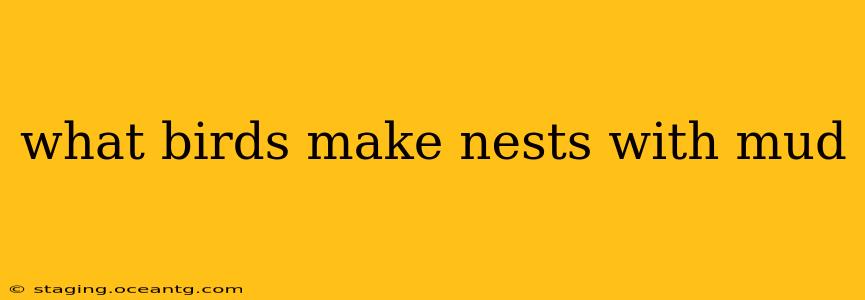What Birds Make Nests with Mud?
Many bird species incorporate mud into their nest construction, using it for various purposes, from structural support to camouflage. While some rely heavily on mud, others use it as a supplementary material. Let's explore some of these fascinating avian architects and their mud-based masterpieces.
What types of birds use mud in their nests?
This is a broad question, as numerous bird species utilize mud in nest building. The specific type of mud nest varies considerably depending on the species. Some create elaborate structures, while others simply use mud as a binding agent. Here are some prominent examples:
-
Swallows: Various swallow species, like the Barn Swallow and Cliff Swallow, are renowned for their mud nests. They expertly craft cup-shaped nests by meticulously layering pellets of mud mixed with saliva and other materials like twigs and grasses. These nests are often attached to cliffs, bridges, or even eaves of buildings.
-
Robins: While not exclusively mud nests, many robin species utilize mud to reinforce and stabilize their cup-shaped nests. They combine mud with grass, twigs, and other plant materials to create a sturdy and secure structure for their eggs.
-
Wrens: Certain wren species, particularly those inhabiting more humid environments, incorporate mud into their nest construction. They often use it as a binding agent to hold together other nesting materials.
-
Ovenbirds: True to their name, ovenbirds construct domed nests resembling small ovens. These nests are predominantly made of mud mixed with grass, moss, and other plant fibers. The dome provides excellent protection from the elements and predators.
-
Hornbills: Several hornbill species construct elaborate nests by sealing themselves into tree cavities with mud. They leave only a small slit for feeding and ventilation. This behavior demonstrates a high level of engineering sophistication.
How do birds make mud nests?
The process of mud nest construction varies depending on the species. However, some common steps include:
-
Gathering Materials: Birds collect mud from various sources, such as muddy puddles, riverbanks, or even moist soil. They often choose mud with the right consistency – not too wet, not too dry.
-
Mixing and Shaping: Many birds mix the mud with saliva to increase its binding properties and improve its workability. They then carefully shape and layer the mud, often combining it with other nesting materials like twigs, grass, feathers, or even hair.
-
Drying and Hardening: Once the mud is in place, it needs to dry and harden. This process can take time, and the birds may frequently return to add more mud and refine the nest's structure.
-
Adding Finishing Touches: After the nest is structurally sound, some species add a lining of softer materials like grass or feathers to provide comfort and insulation for the eggs and hatchlings.
What are the benefits of mud nests?
Mud offers several advantages in nest construction:
-
Strength and Stability: Mud provides excellent structural integrity, creating a strong and durable nest capable of withstanding wind, rain, and other environmental stresses.
-
Camouflage: The coloration of mud can help camouflage the nest, making it less visible to predators.
-
Protection from Predators: The thick mud walls of some nests (like ovenbird nests) offer significant protection against predators.
-
Insulation: The mud walls can also provide insulation, helping to maintain a stable temperature within the nest.
What other materials do birds use besides mud?
While mud is a key component for some, birds often use a diverse range of materials, including twigs, grasses, leaves, moss, feathers, hair, spider silk, and even bits of plastic or string. The specific materials used depend on the species, their environment, and the availability of resources.
By understanding the intricate details of avian nest construction, we gain a deeper appreciation for the ingenuity and adaptability of these remarkable creatures. The use of mud, in particular, highlights their resourcefulness and the sophisticated engineering involved in building a safe and protective home for their offspring.
